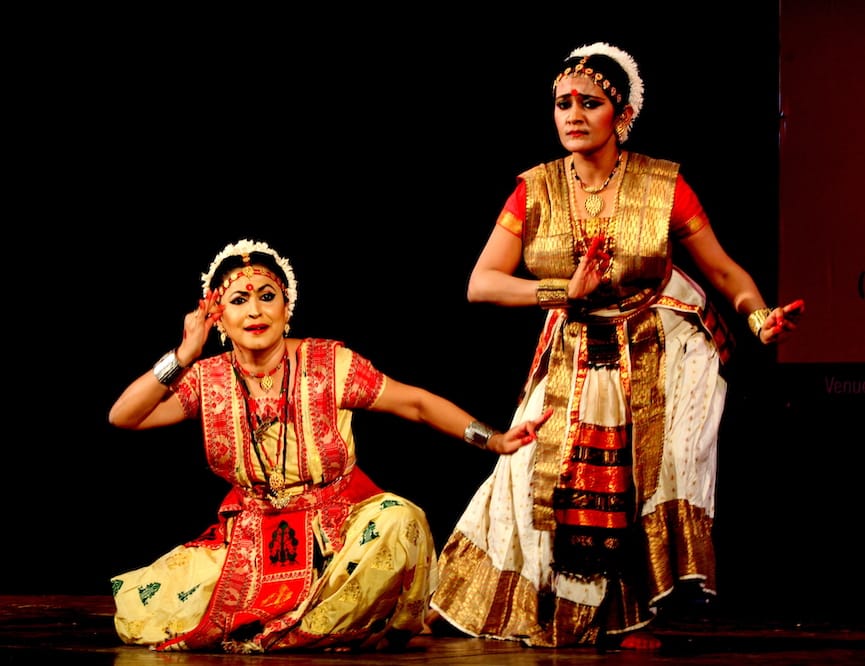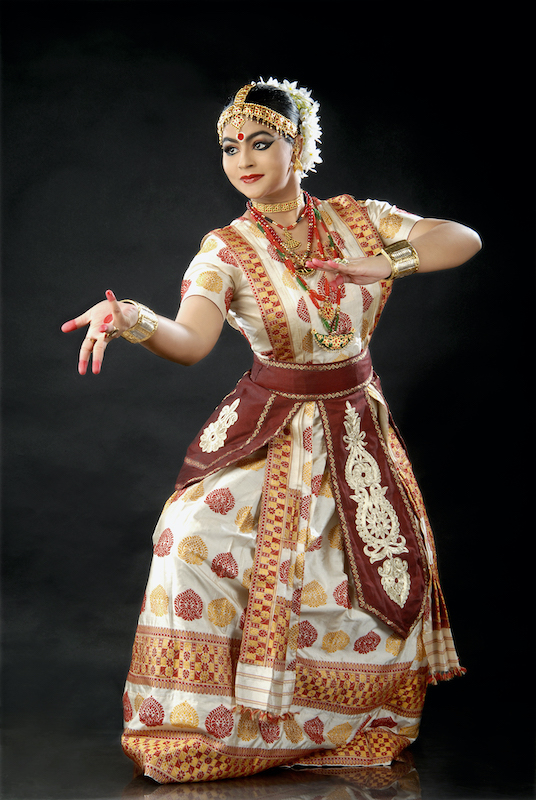Sattriya: Reverence, Rhythm, and Tradition

Sattriya, a classical dance form originating from the northeastern state of Assam, holds a significant place in India’s rich cultural heritage. Rooted in the devotional practices of the region, Sattriya was traditionally performed by monks in the Sattras, or monasteries, as a means of worship and storytelling. Characterized by its graceful movements, intricate gestures, and spiritual themes, Sattriya is deeply intertwined with the Vaishnavite tradition and is particularly devoted to Lord Krishna. As we delve into the world of Sattriya, we uncover not only its artistic beauty but also its profound spiritual significance, making it a cherished treasure of Assamese culture.
Historical Background
Sattriya, as a classical dance form, has a rich historical background that traces its evolution and development over centuries. Emerging from the Sattras, or Vaishnavite monasteries, of Assam, Sattriya finds its roots deeply embedded in the cultural and religious practices of the region.
The origins of Sattriya can be traced back to the 15th century when the revered Assamese saint and social reformer, Srimanta Sankardeva, laid the foundation for this dance form as a mode of expressing devotion to Lord Krishna. Alongside his disciple Madhavdeva, Sankardeva composed numerous dance dramas known as “Ankia Naat” or “Bhaona,” which formed the core repertoire of Sattriya.
Initially, Sattriya was exclusively performed within the confines of the Sattras by male monks known as “bhokots” or “bhakats.” These monks, dedicated to a life of devotion and service, utilized Sattriya as a means of religious expression, combining intricate dance movements with soul-stirring music and poetry to convey tales from Hindu mythology and the teachings of Vaishnavism.

Over time, Sattriya evolved from a devotional ritual to a refined art form, gaining recognition as one of the eight classical dance forms of India in the mid-20th century. Despite facing periods of decline and suppression during various historical upheavals, Sattriya persevered through the efforts of dedicated practitioners and scholars who worked tirelessly to preserve and revive its traditions.
Today, Sattriya stands as a testament to the resilience and cultural heritage of Assam, continuing to captivate audiences with its timeless beauty and spiritual depth. As we explore the historical background of Sattriya, we gain insight into the profound significance of this ancient dance form and its enduring legacy in the cultural tapestry of India.
Characteristics of Sattriya
Sattriya dance is characterized by its unique movements, costumes, makeup, and musical accompaniment, each contributing to its distinct identity and aesthetic appeal. Understanding these key characteristics offers insight into the artistry and beauty of Sattriya.
A. Costumes and Makeup:
1. Sattriya costumes are elegant and symbolic, reflecting the traditional attire worn by monks in the Sattras. Male dancers typically wear dhotis (traditional garments) with a waistband, while female dancers adorn themselves in graceful sarees or mekhela chadors (Assamese attire).
2. The makeup in Sattriya is minimalistic yet striking, emphasizing the expressive features of the dancers. Male dancers often apply a tilak (religious mark) on their forehead, while both male and female dancers may use subtle makeup to enhance facial expressions under the stage lights.
B. Movements and Gestures:
1. Sattriya is characterized by fluid and graceful movements that convey a sense of lyrical beauty and spiritual devotion. The dance repertoire includes a wide range of movements, from gentle swaying motions to intricate footwork and dramatic leaps.
2. Hand gestures, known as hastas, play a crucial role in Sattriya, with each gesture carrying symbolic meaning and emotional expression. Dancers use mudras (hand gestures) to depict characters, convey emotions, and narrate stories from Hindu mythology with precision and clarity.
C. Musical Accompaniment:
1. Sattriya is accompanied by traditional Assamese music, comprising a diverse range of instruments such as khol (a barrel-shaped drum), cymbals, flute, violin, and the unique string instrument known as the dotara.
2. The music in Sattriya is characterized by its melodic richness and rhythmic complexity, providing a vibrant backdrop for the dancers’ movements. Live musicians often accompany Sattriya performances, creating an immersive auditory experience for the audience.
Understanding these characteristics illuminates the intricate artistry and cultural significance of Sattriya dance, showcasing its ability to convey stories, emotions, and spiritual devotion through the harmonious interplay of movement and music.
Themes and Devotion in Sattriya
Sattriya dance is deeply rooted in the Bhakti (devotional) tradition of Vaishnavism, particularly the worship of Lord Krishna. Themes of devotion, spirituality, and divine love permeate every aspect of Sattriya, shaping its narratives, choreography, and emotional expression.
A. Influence of Vaishnavism:
1. Sattriya draws inspiration from the teachings of Vaishnavite saints, particularly Srimanta Sankardeva and Madhavdeva, who propagated the Bhakti movement in Assam during the 15th and 16th centuries.
2. Central to Sattriya is the worship of Lord Krishna as the divine lover and supreme deity, with many dance compositions dedicated to depicting episodes from Krishna’s life, such as his childhood antics (Baal Leela), his divine love with Radha (Raas Leela), and his heroic exploits (Kaliya Daman, Govardhan Leela).
B. Depiction of Stories from Hindu Mythology:
1. Sattriya dance repertoire includes a wide array of mythological narratives drawn from Hindu epics such as the Ramayana, Mahabharata, and Puranas.
2. Dancers portray various mythological characters and divine beings, from gods and goddesses to demons and celestial beings, through expressive movements, gestures, and facial expressions.
C. Spiritual and Emotional Expression:
1. Sattriya serves as a medium for spiritual expression and devotion, allowing dancers to embody the divine and transcendental aspects of Vaishnavite philosophy.
2. Through their performances, Sattriya dancers invoke a sense of bhava (emotional expression) and rasa (aesthetic sentiment), evoking feelings of love, devotion, joy, compassion, and transcendence in both themselves and the audience.
The themes of devotion and spirituality in Sattriya underscore its profound cultural and religious significance, serving as a means of connecting practitioners and spectators with the divine and imparting moral and spiritual teachings through the universal language of dance. As we explore the themes of Sattriya, we gain a deeper understanding of its role as a sacred art form and cultural heritage of Assam.

Significance and Cultural Impact
Sattriya holds immense significance within the cultural landscape of Assam and India as a whole, serving as a symbol of tradition, spirituality, and artistic excellence. Its cultural impact extends beyond the confines of the Sattras, influencing literature, music, theater, and dance forms across the region.
A. Importance of Sattriya in Assamese Culture:
1. Sattriya is regarded as a cultural treasure of Assam, reflecting the state’s rich history, religious heritage, and social fabric.
2. The dance form plays a vital role in preserving and promoting Assamese identity, fostering a sense of pride and belonging among the people of Assam.
B. Recognition as a Classical Dance Form:
1. In recognition of its artistic merit and cultural significance, Sattriya was conferred classical status by the Government of India in 2000, alongside other classical dance forms such as Bharatanatyam, Kathak, Odissi, Kuchipudi, Manipuri, and Kathakali.
2. This official recognition elevated Sattriya to a national platform, providing opportunities for practitioners to showcase their talent and repertoire on prestigious stages and platforms across India and around the world.
C. Influence on Assamese Arts and Culture:
1. Sattriya has left an indelible mark on Assamese arts and culture, inspiring the creation of literature, poetry, music, and visual arts that draw upon its themes, motifs, and aesthetic principles.
2. The cultural impact of Sattriya extends beyond its role as a dance form, influencing societal norms, religious practices, and festive celebrations in Assam.
Through its significance and cultural impact, Sattriya continues to thrive as a dynamic and evolving art form, bridging the past with the present and serving as a beacon of artistic expression and cultural heritage for generations to come. As we examine its significance, we recognize the enduring legacy of Sattriya in shaping the cultural identity and artistic landscape of Assam and India.





